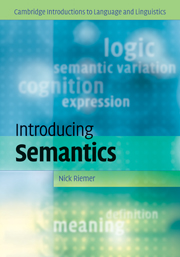Book contents
- Frontmatter
- Contents
- Note to the reader
- 1 Meaning in the empirical study of language
- 2 Meaning and definition
- 3 The scope of meaning I: external context
- 4 The scope of meaning II: interpersonal context
- 5 Analysing and distinguishing meanings
- 6 Logic as a representation of meaning
- 7 Meaning and cognition I: categorization and cognitive semantics
- 8 Meaning and cognition II: formalizing and simulating conceptual representations
- 9 Meaning and morphosyntax I: the semantics of grammatical categories
- 10 Meaning and morphosyntax II: verb meaning and argument structure
- 11 Semantic variation and change
- Glossary
- References
- Index
Note to the reader
Published online by Cambridge University Press: 05 June 2012
- Frontmatter
- Contents
- Note to the reader
- 1 Meaning in the empirical study of language
- 2 Meaning and definition
- 3 The scope of meaning I: external context
- 4 The scope of meaning II: interpersonal context
- 5 Analysing and distinguishing meanings
- 6 Logic as a representation of meaning
- 7 Meaning and cognition I: categorization and cognitive semantics
- 8 Meaning and cognition II: formalizing and simulating conceptual representations
- 9 Meaning and morphosyntax I: the semantics of grammatical categories
- 10 Meaning and morphosyntax II: verb meaning and argument structure
- 11 Semantic variation and change
- Glossary
- References
- Index
Summary
This introduction is intended for anyone coming to linguistic semantics for the first time, whether as part of a linguistics degree or independently. The best way to approach the contents is to work through the chapters in the order in which they appear. This is not the only way, however: after the first chapter, the rest of the book has a modular structure and can be read in whatever sequence the reader prefers. Chapter 1 lays out the framework for what follows and explains some important preliminary ideas; once the reader has familiarized themselves with these, they have all they need in order to begin reading anywhere else. For someone adopting this approach to the book, the glossary explains the most important recurrent terms, and can be consulted whenever an unfamiliar concept is encountered. The exercises interspersed throughout the text and at the end of each chapter are designed to deepen the reader's engagement with the material, and contain a mixture of questions of different lengths and degrees of concreteness and difficulty.
A few comments about the spirit in which the book has been written may be useful. Semantics is surely distinctive among the staple components of the introductory linguistics curriculum in the lack of disciplinary agreement over the basic theoretical questions at its centre. Langacker's (1987: 32) complaint about ‘the striking lack of consensus about the proper characterization of even the simplest or most fundamental linguistic phenomena’ applies in questions of meaning even more than elsewhere in the discipline, and theoretical proliferation in the years that separate us from 1987 has only increased the diversity of approaches available.
- Type
- Chapter
- Information
- Introducing Semantics , pp. xiii - xviPublisher: Cambridge University PressPrint publication year: 2010

